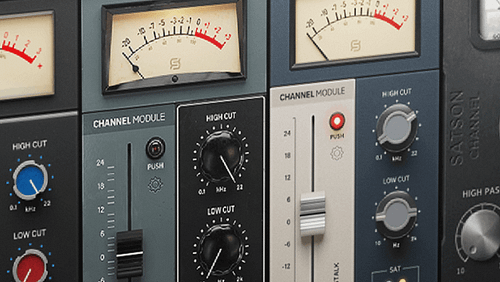The ’90s gave us some of the most legendary hits in music history. All-time classics like ‘Smells Like Teen Spirit,’ ‘Wonderwall,’ ‘Wannabe,’ ‘Basket Case’ and many more were released in the decade when rock and pop reigned on the charts. A key element in the sound of that decade and beyond came from the hand of one audio device in the center section of the 4000 G-Series console. We are talking about the G-bus Compressor.
With many clones, reincarnations, and plugins emulating this compressor, there is no doubt that it’s one of the tools that helped shape the sound of modern records. Let’s see what makes this compressor so iconic.
Also read: Not Just Another G-Series Clone
The Origin
The 4000-G series analog console is considered by many to be the most successful studio production console. Introduced to the market in 1987, it was the first console to incorporate dynamic processing in every channel and a stereo master compressor.
With a very limited range of settings compared to other VCA compressors, this small rectangle with 5 knobs in the master section of the console delivered punch, drive, and added ‘glue’ to every mix.
Designed around the BBC’s ‘State Broadcast’ compressor, the G-bus compressor employs a feedback design system and a Voltage Control Amplifier (VCA) to control the level reduction. This means that the signal going into the compressor is split in two: the VCA that compresses the signal, and the detection circuit which tells the VCA how much compression should be applied. The peculiarity of the G-bus compressor is that the detection circuit is after the VCA. This fact might sound impossible but because the electrons move very quickly, the compressor still manages to carry the gain reduction.
As a result of this design, transients tend to pass through before the VCA responds and also the device varies the compression knee according to the set ratio. The G-bus compressor delivers smaller amounts of gain reduction under faster attack and release times, while slower settings provide larger amounts of compression. Finally the auto-release option makes the release time program-dependent just so faster sounds like transients will show faster release times, while slower decay sounds will have slower release times.
In conclusion, the G-bus compressor excels at subtly subduing the dynamics of the most complex mix, gluing everything together perfectly.
Satson CS

Inspired by this classic gear, Sonimus created the Satson compressor module for its first channel strip: the Satson CS.
The compressor takes the main features of the classic design and makes them its own. While the ratios are the same as the original G-bus, the attack time control is continuous, and an extra release time position at 0.9 seconds has been added. Also, the addition of an internal side-chain filter, similar to the 500 series version of the G-bus, allows for even more control over the response of the compressor against low-frequencies.
Finally the availability of a mix knob together with the possibility of choosing between stereo link, dual mono or mono processing are great features to use this module in all different kinds of scenarios: whether for adding instant parallel compression to any kind of audio source, or to use it for mastering.
The Satson compressor module sounds fantastic not only in your mix bus, but also in any audio source, mono or stereo. Use it to add punch to your drums, give clarity and consistency to your vocals or control the dynamic of your bass to make it sit right in the mix.
Great to use on its own, or together with the rest of the Satson CS modules. The compressor module is a fantastic addition to your plugin collection, and thanks to the flexibility of Sonimus’ modular approach, you can combine it in any way you want.
The glue that your mixes were missing, together with the warmth of an analog console — can you ask for much more?
Written By Carlos Bricio







Hi Mike,
I’m glad you liked the article. You are right about the TG being the first console with dynamics on every channel, but what I wrote was that the SSL-G was the first console to have dynamics on every channel AND a master stereo compressor. That was the information that I found on my research but perhaps I should have rephrased the statement so there were no misinterpretations.
I also heard that statement from SSL! I won’t be surprised if it’s true to be honest :) It is a signature sound of that decade.
Nice article, but a huge error in the description of the SSL G. The first console to have Dynamics and EQ in every channel was the EMI TG 12345 consoles from the mid 60’s to early 70’s. The SSL G console was not even the first SSL console to have dynamics on every channel, that was the B-Series dating back to the mid 70’s. There was a study by SSL in the early 90’s that claimed that 90% of all records in the Billboard singles chart at that time had been mixed on SSL consoles. Not sure how to verify that, but I mixed many records on the E and G consoles from that time and it was a signature sound for that era and the many years that followed.
Cheers!
Mixing With Mike